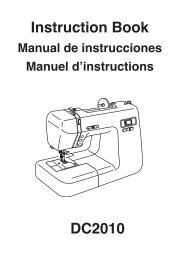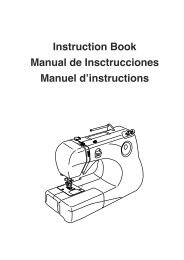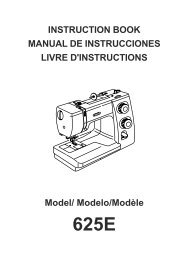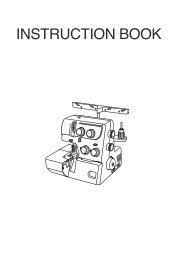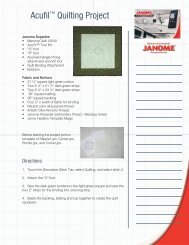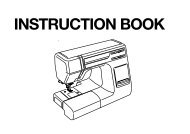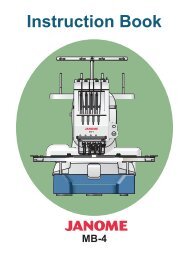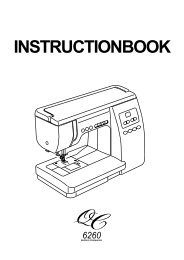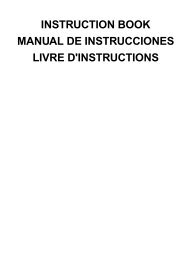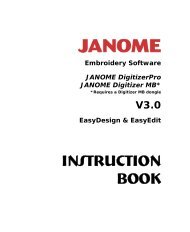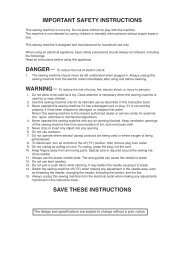INSTRUCTION BOOK MANUAL DE INSTRUCCIONES ... - Janome
INSTRUCTION BOOK MANUAL DE INSTRUCCIONES ... - Janome
INSTRUCTION BOOK MANUAL DE INSTRUCCIONES ... - Janome
You also want an ePaper? Increase the reach of your titles
YUMPU automatically turns print PDFs into web optimized ePapers that Google loves.
Troubleshooting<br />
Condition Cause Reference<br />
The needle thread<br />
breaks.<br />
1. The needle thread is not threaded properly.<br />
Page 20<br />
2. The needle thread tension is too tight.<br />
Pages 22, 24<br />
3. The needle is bent or blunt.<br />
Page 12<br />
4. The needle is incorrectly inserted.<br />
Page 12<br />
5. The needle thread and the bobbin thread are not set properly Page 20<br />
under the presser foot at the beginning of sewing.<br />
6. The fabric is not drawn to the rear when the sewing has Page 28<br />
finished.<br />
7. The thread is too heavy or too fine for the needle.<br />
Page 12<br />
The bobbin thread<br />
breaks.<br />
The needle breaks.<br />
1. The bobbin thread is not threaded properly in the bobbin<br />
case and shuttle.<br />
2. Lint has collected in the shuttle area.<br />
3. The bobbin is damaged and doesn't turn smoothly.<br />
1. The needle is incorrectly inserted.<br />
2. The needle is bent or blunt.<br />
3. The needle clamp screw is loose.<br />
4. The needle thread tension is too tight.<br />
5. The fabric is not drawn to the rear when the sewing has<br />
finished.<br />
6. The needle is too fine for the fabric being sewn.<br />
Page 18<br />
Page 54<br />
Change the bobbin<br />
Page 12<br />
Page 12<br />
Page 12<br />
Pages 22, 24<br />
Page 28<br />
Page 12<br />
Skipped stitches<br />
1. The needle is incorrectly inserted.<br />
2. The needle is bent or blunt.<br />
3. The needle and/or threads are not suitable for the work being<br />
sewn.<br />
4. A blue needle is not being used for sewing stretch, very fine<br />
fabrics and synthetics.<br />
5. The needle thread is not threaded properly.<br />
6. The wrong needle is being used.<br />
Page 12<br />
Page 12<br />
Page 12<br />
Page 12<br />
Page 20<br />
Change the needle<br />
Seam puckering<br />
The cloth is not<br />
feeding smoothly.<br />
The machine doesn’t<br />
work.<br />
Patterns are<br />
distorted.<br />
Noisy operation<br />
1. The needle thread tension is too tight.<br />
2. The needle thread is not threaded properly.<br />
3. The needle is too heavy for the fabric being sewn.<br />
4. The stitch length is too long for the fabric.<br />
1. The feed dog is packed with lint.<br />
2. The stitches are too fine.<br />
3. The feed dog is not raised after “drop feed” sewing.<br />
1. The machine is not plugged in.<br />
2. A thread is caught in the shuttle race.<br />
3. The clutch is disengaged.<br />
1. The stitch is not balanced.<br />
1. There is thread caught in the hook race.<br />
2. Lint has built up in the shuttle or the shuttle race.<br />
Pages 22, 24<br />
Page 20<br />
Page 12<br />
Make stitch denser<br />
Page 52<br />
Make stitch coarser<br />
Page 10<br />
Page 6<br />
Page 54<br />
Page 16<br />
Page 26<br />
Page 54<br />
Page 54<br />
58




